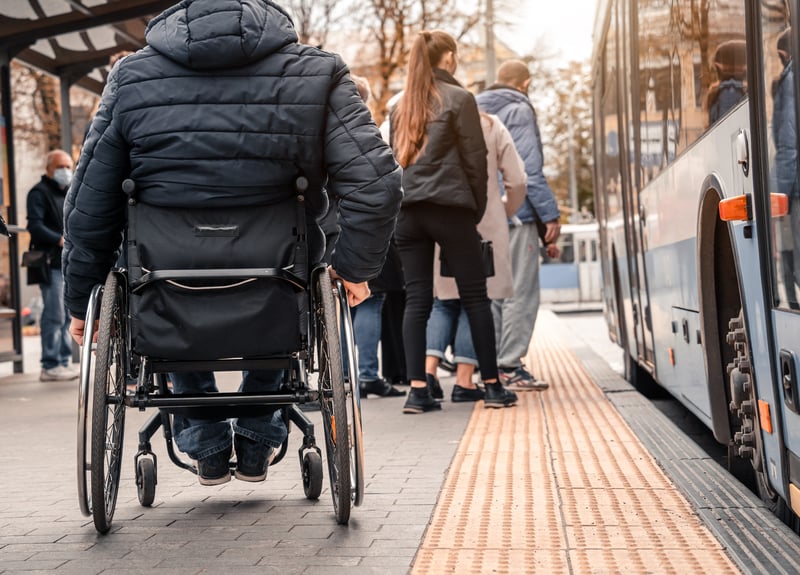The Americans with Disabilities Act (ADA), signed into law on July 26, 1990, brought major improvements to public transportation for people with disabilities. It required accessible vehicles and facilities, introduced paratransit services, and ensured fair treatment, making it much easier for disabled riders to get around and enjoy greater independence. As we celebrate the anniversary of the ADA, it is important to recognize the critical role that public transit agencies and innovative technology play in making transportation more accessible and inclusive for everyone.
Public Transit’s Role in Building Inclusive Communities
Public transit is a lifeline for individuals with disabilities, providing crucial access to essential services and opportunities. Transit agencies have a responsibility to ensure their services are not only dependable but also accessible to all. By leveraging technology, agencies can provide accurate and timely information that empowers disabled passengers to navigate the transit system confidently and independently.
Ensuring Safety Through Onboard Information
Accurate and timely onboard information is key to ensuring the safety and confidence of all passengers, particularly those with disabilities. Digital signage and automated announcements play a crucial role in this regard:
- Digital Signage: For audio-impaired passengers, digital signs offer real-time updates on bus arrivals, delays, and route changes, ensuring they are always informed and can make safe decisions.
- Automated Announcements: For visually impaired passengers, clear and loud audio announcements provide timely information about stops, route changes, and safety alerts. Furthermore, hearing loop integration ensures audible clarity and comfort for hearing-impaired passengers.
And because unforeseen disruptions like a water main rupture, snowstorm, or fallen tree can affect service, it is critical that passengers with visual and auditory disabilities are quickly and seamlessly updated. A powerful CAD system with Disruption Management capabilities is crucial to ensure that passengers receive real-time schedule and route updates via both digital signage and automated audio announcements.
When combined, these tools help ensure that all passengers, regardless of their abilities, have access to the information they need to travel safely and independently.

Strengthening Social Inclusion and Increasing Autonomy
Reliable public transit helps reduce social isolation and increase autonomy for individuals with disabilities. With a median income of $42,800 for households with a disabled member - significantly lower than the median income of $65,400 in households without a disabled member (U.S. Census Bureau 2020) - private transportation is often unaffordable, making public transit essential.
In 2022, only 52.8% of working-age individuals with disabilities drove a private vehicle, compared to 78.2% of those without disabilities (Bureau of Transportation Statistics). Dependable public transportation enables disabled individuals to maintain social connections, expand employment opportunities, engage in community activities, and access essential services.
For many, public transit is the only viable option for maintaining employment and participating in social and community activities.
Ensuring Access to Transit
Transit agencies must continually work to enhance accessibility for individuals with disabilities. One of the easiest ways to do that is through advanced ITS technology solutions.
For instance, advanced APC technology and ridership reporting software provides crucial data on wheelchair ramp deployments and differentiates when actual wheelchairs, as opposed to grocery carts or strollers, board the vehicle. This information helps transit agencies and municipalities to improve infrastructure, such as sidewalks and curb cuts, at and around stops with the highest wheelchair usage, ensuring better accessibility for all.
Clever Devices has also partnered with NaviLens, a company specializing in cutting-edge visual signage for the visually impaired. This partnership is working on several projects to further enhance the accessibility of bus stops, train stations, and subway stations. NaviLens technology uses high-contrast, QR-like codes that can be scanned from a distance with a smartphone, providing audio and visual information about transit services, thereby making navigation easier for visually impaired passengers. This collaboration underscores our commitment to leveraging innovative technology to improve accessibility for all transit users.
Paratransit Services
While many individuals with disabilities can use regular transit services thanks to accessible buses, trains, and stations, others require additional assistance due to more severe mobility challenges. This is where paratransit services, powered by customized ITS solutions, become crucial. These services complement traditional transit by catering to people with a wide range of disabilities, providing essential support for those who need more assistance than standard transit can offer.
Advanced paratransit technology enhances the overall experience for riders and helps transit agencies optimize their resources, ensuring better accessibility for everyone. Providing door-to-door transportation for those who cannot navigate standard transit options ensures they can still access essential services, work, and community activities. By offering tailored support, paratransit services play a vital role in ensuring equitable transportation access for all individuals with disabilities.

Safe and Reliable Transportation for All Passengers
As we commemorate the ADA's anniversary, it’s crucial to acknowledge the strides made in accessible public transit and the ongoing efforts needed to support the disabled community. Public transit agencies, empowered by advanced technology, play a vital role in ensuring mobility, independence, and equality for all passengers. By continuing to innovate and invest in accessible solutions, we can create a more connected and inclusive society for everyone.
Clever Devices’ solutions help transit agencies deliver safe and reliable transportation to all passengers. Learn more about our solutions that increase safety, confidence, and independence for passengers with disabilities: